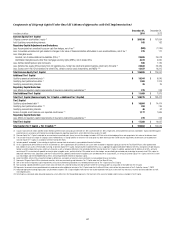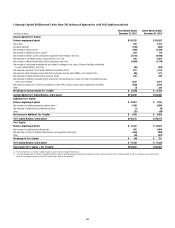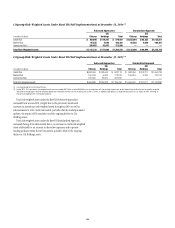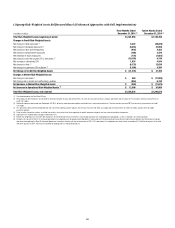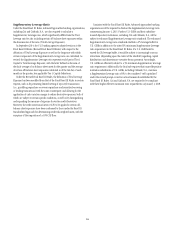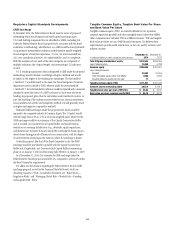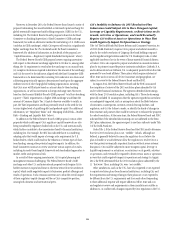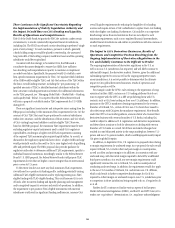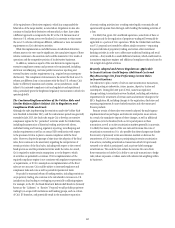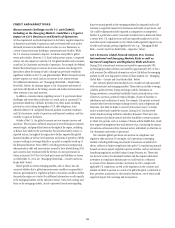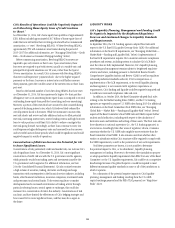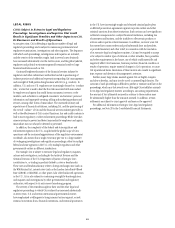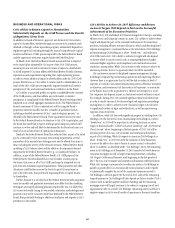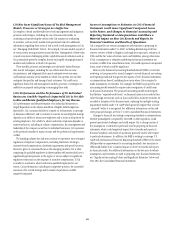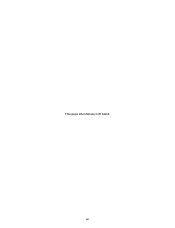Citibank 2014 Annual Report Download - page 74
Download and view the complete annual report
Please find page 74 of the 2014 Citibank annual report below. You can navigate through the pages in the report by either clicking on the pages listed below, or by using the keyword search tool below to find specific information within the annual report.57
of the equivalency of derivatives regimes), which has compounded the
bifurcation of the swaps market, as noted above. Regulators in Asia also
continue to finalize their derivatives reforms which, to date, have taken
a different approach as compared to the EU or the U.S. Because most of
these non-U.S. reforms are not yet finalized, it is uncertain to what extent
the non-U.S. reforms will impose different, additional or even inconsistent
requirements on Citi’s derivatives activities.
While the implementation and effectiveness of individual derivatives
reforms may not in every case be significant, the cumulative impact of these
reforms continues to be uncertain and could be material to Citi’s results of
operations and the competitive position of its derivatives businesses.
In addition, numerous aspects of the new derivatives regime require
extensive compliance systems and processes to be maintained, including
electronic recordkeeping, real-time public transaction reporting and
external business conduct requirements (e.g., required swap counterparty
disclosures). This compliance risk increases to the extent the final non-U.S.
reforms are different from or inconsistent with the final U.S. reforms. Citi’s
failure to effectively maintain such systems, across jurisdictions, could
subject it to increased compliance costs and regulatory and reputational
risks, particularly given the heightened regulatory environment in which Citi
operates globally.
The Continued Implementation of the Volcker Rule and
Similar Reform Efforts Subject Citi to Regulatory and
Compliance Risks and Costs.
Although the rules implementing the restrictions under the Volcker Rule
were finalized in December 2013, and the conformance period was generally
extended to July 2015, the final rules require Citi to develop an extensive
compliance regime for the “permitted” activities under the Volcker Rule,
including documentation of historical trading activities with clients,
individual testing and training, regulatory reporting, recordkeeping and
similar requirements as well as an annual CEO certification with respect
to the processes Citi has in place to ensure compliance with the final
rules. Moreover, despite the passage of time since the adoption of the final
rules, there continues to be uncertainty regarding the interpretation of
certain provisions of the final rules, including with respect to the covered
funds provisions and the permitted activities under the rules. As a result,
Citi is required to make certain assumptions as to the degree to which
its activities are permitted to continue. If Citi’s implementation of the
required compliance regime is not consistent with regulatory expectations
or requirements, or if Citi’s assumptions in implementation of the final
rules are not accurate, Citi could be subject to increased regulatory and
compliance risks and costs as well as potential reputational harm.
Proposals for structural reform of banking entities, including restrictions
on proprietary trading, also continue to be introduced in various non-U.S.
jurisdictions, thus leading to overlapping or potentially conflicting regimes.
For example, in the EU, the Bank Structural Reform draft directive (formerly
known as the “Liikanen” or “Barnier” Proposal) would prohibit proprietary
trading by in-scope credit institutions and banking groups, such as certain
of Citi’s EU branches, and potentially result in the mandatory separation
of certain trading activities into a trading entity legally, economically and
operationally separate from the legal entity holding the banking activities of
a firm.
It is likely that, given Citi’s worldwide operations, some form of these or
other proposals for the regulation of proprietary trading will eventually be
applicable to a portion of Citi’s operations. While the Volcker Rule and these
non-U.S. proposals are intended to address similar concerns—separating
the perceived risks of proprietary trading and certain other investment
banking activities in order not to affect more traditional banking and retail
activities—they would do so under different structures, which could result in
inconsistent regulatory regimes and additional compliance risks and costs for
Citi in light of its global activities.
Recently Adopted and Future Regulations Applicable
to Securitizations Could Impose Additional Costs and
May Discourage Citi from Performing Certain Roles
in Securitizations.
Citi endeavors to play a variety of roles in asset securitization transactions,
including acting as underwriter, issuer, sponsor, depositor, trustee and
counterparty. During the latter part of 2014, numerous regulatory
changes relating to securitizations were finalized, including risk retention
requirements for securitizers of certain assets and extensive changes to the
SEC’s Regulation AB, including changes to the registration, disclosure and
reporting requirements for asset-backed securities and other structured
finance products.
Because certain of these rules were recently adopted, the multi-agency
implementation has just begun and extensive interpretive issues remain.
As a result, the cumulative impact of these changes, as well as additional
regulations yet to be finalized, both on Citi’s participation in these
transactions as well as on the securitization markets generally, is uncertain.
It is likely that many aspects of the new rules will increase the costs of
securitization transactions. It is also possible that these changes may hinder
the recovery of previously active securitization markets or decrease the
attractiveness of Citi’s executing or participating in certain securitization
transactions, including securitization transactions which Citi previously
executed or in which it participated, such as private-label mortgage
securitizations. This could in turn reduce the income Citi earns from
these transactions or hinder Citi’s ability to use such transactions to hedge
risks, reduce exposures or reduce assets with adverse risk-weighting within
its businesses.


